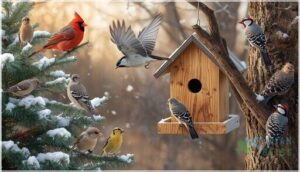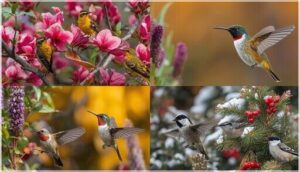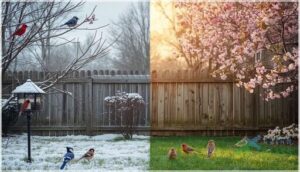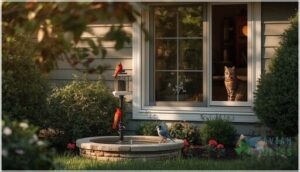This site is supported by our readers. We may earn a commission, at no cost to you, if you purchase through links.
You step outside with your morning coffee and notice a flash of red at the feeder. A Northern Cardinal lands on the rim and begins cracking seeds. Minutes later, a woodpecker drums on the oak tree while goldfinches flutter past in waves of yellow.
New Jersey’s backyard birds offer this kind of daily entertainment throughout the year. Over 400 species pass through the state, but a core group of residents and seasonal visitors make regular appearances in suburban yards.
Learning to identify these birds transforms your outdoor space into a front-row seat for migration patterns, breeding behaviors, and survival strategies that unfold right outside your window.
Table Of Contents
- Key Takeaways
- Common Backyard Birds in New Jersey
- Identifying New Jersey’s Backyard Birds
- Attracting Birds to Your New Jersey Yard
- Seasonal Bird Watching in New Jersey
- Supporting and Protecting Backyard Birds
- Frequently Asked Questions (FAQs)
- What are the most common backyard birds in New Jersey?
- What is New Jersey’s state bird?
- What birds can you see in New Jersey?
- Is New Jersey a good state for birding?
- What do acrobatic birds look like in New Jersey?
- What birds eat seeds in New Jersey?
- What is the most common bird in NJ?
- How can I identify a bird in my yard?
- What is the most common backyard bird?
- What are the little yellow birds in New Jersey?
- Conclusion
Key Takeaways
- Over 400 bird species pass through New Jersey, with year-round residents like Northern Cardinals and seasonal migrants following the Atlantic Flyway making backyards prime viewing spots throughout the year.
- You can attract more birds by offering black oil sunflower seeds in tube feeders, maintaining clean water sources with 1-2 inch depth, and planting 50-70% native species to provide insects and natural cover.
- Window collisions kill over a billion birds annually in the U.S., but you can prevent up to 95% of these deaths by applying markers or patterns spaced two inches or less on the outside of your glass.
- Properties with diverse native plants support twice as many bird species as conventional lawns because they provide the insects, seeds, and shelter that birds need for survival and successful nesting.
Common Backyard Birds in New Jersey
New Jersey’s backyards are home to a surprising variety of birds, from tiny woodpeckers to bold blue jays. Some species stick around all year, while others only visit during specific seasons.
Let’s look at the birds you’re most likely to see outside your window, organized by when they appear and what makes them stand out.
Year-Round Resident Species
New Jersey’s year-round resident birds don’t pack up when winter arrives. Northern Cardinals, American Goldfinches, and Mourning Doves stick around all twelve months, so you’ll find them at your feeders in January and July alike.
Chickadees, Tufted Titmice, and White-breasted Nuthatches stay on territory for life. Downy and Red-bellied Woodpeckers also remain year-round, making backyard bird identification easier once you learn these familiar faces.
The most common bird seen is the Dark-eyed Junco.
Seasonal Migrants and Visitors
While residents stay put, seasonal migrants and visitors arrive in waves along the Atlantic Flyway. Spring migration peaks in late April and May, bringing warblers, orioles, and Ruby-throated Hummingbirds to your yard. Fall migration runs August through November, when these summer birds head south.
The flyway itself includes crucial stopover points that provide refuge for migrating species.
Winter birds like White-throated Sparrows and Dark-eyed Juncos replace them, transforming your backyard’s seasonal bird sightings completely.
Woodpeckers, Songbirds, and Other Notable Groups
Beyond these seasonal visitors, you’ll see distinct backyard guilds throughout New Jersey. Seven woodpecker species use your yard, from tiny Downies to crow-sized Pileateds.
About 150 songbird species breed here, most migrating to the tropics each fall. Raptor populations are rebounding too—Bald Eagles now nest in all 21 counties.
Each group fills its own niche in your backyard ecosystem.
Identifying New Jersey’s Backyard Birds
Learning to identify backyard birds takes a little practice, but you don’t need to be an expert to get started. By paying attention to a few key features like color patterns, body shape, and how a bird behaves, you can narrow down what you’re seeing pretty quickly.
Let’s look at the main field marks and clues that will help you put a name to the birds visiting your yard.
Key Field Marks and Plumage Patterns
When identifying backyard birds in New Jersey, plumage coloration gives you the first clue. Adult male Northern Cardinals stay bright red year-round, while American Goldfinches switch from vivid yellow in summer to dull olive in winter.
Wing patterning helps too—Red-bellied Woodpeckers show bold black-and-white barring, and Northern Flickers reveal yellow wing shafts in flight. Head markings and underpart patches complete the picture.
Size, Shape, and Bill Characteristics
Body structure gives you quick bird identification clues in your backyard. Tiny American Goldfinches measure just 4.3 to 5.1 inches, while Common Grackles stretch up to 15.4 inches.
Bill morphology matters too—Northern Cardinals use thick finch bills to crack seeds, and Downy Woodpeckers wield stubby bills to chisel bark. Shape variation helps separate similar bird species even before you notice plumage patterns.
Behavior, Habitat, and Vocalizations
Foraging behavior reveals identity—Gray Catbirds spend 60 to 70% of daylight hours hunting insects in dense shrubs, while Northern Cardinals crack seeds on the ground beneath your feeders.
Habitat selection matters too. Yards with native plants support eight times more woodland species than lawn-only properties.
Listen for vocal adjustments in noisy areas, where birds raise pitch to cut through traffic hum and improve space use across your backyard.
Attracting Birds to Your New Jersey Yard
Turning your yard into a bird haven doesn’t require a lot of fancy equipment or expertise.
A few simple additions can make your outdoor space irresistible to New Jersey’s feathered residents and visitors.
Here’s what works best to bring more birds right to your doorstep.
Best Bird Feeders and Food Types
The right bird feeders and bird food can transform your yard into a haven for New Jersey’s backyard species. Black oil sunflower seeds in tube feeders attract cardinals and finches, while safflower seeds in hopper feeders appeal to cardinals and chickadees without drawing grackles. Suet feeders bring in downy woodpeckers and nuthatches year-round.
Consider these feeder types:
- Tube feeders with 6-8 perches accommodate multiple birds simultaneously
- Platform feeders enable ground-feeding mourning doves and juncos to access cracked corn
- Suet cages provide essential fats for winter survival of 10+ species
Proper feeder placement and hygiene prevent disease spread. Clean seed feeders every two weeks, and rotate seed mixes seasonally. Budget feeders work well when stocked with quality bird seed—hulled sunflower seeds and shelled peanuts reduce waste. Understanding bird feeder preferences helps you match the right setup to your target species, while squirrel prevention measures like baffles protect your investment.
Providing Water Sources and Bird Baths
Water features like bird baths draw as many species as feeders—sometimes more. Install a bath with 1–2 inch water depth so small warblers and larger cardinals can both drink safely.
Change bath water daily to prevent disease and mosquito control issues. Place your bath 10–12 feet from cover for safety, and keep water open all winter to attract backyard birds when natural sources freeze.
Native Plants and Landscaping Tips
Native plants supply the insect prey and plant cover birds need most. Aim for 50–70% native species in your yard design to support nesting success. Layer canopy trees with understory shrubs and grasses for stronger plant structure.
Your management practices matter too—skip pesticides to keep caterpillars abundant. This wildlife-friendly landscaping turns your backyard habitat into a true refuge that will attract birds year-round.
Seasonal Bird Watching in New Jersey
New Jersey’s bird population changes throughout the year as species come and go with the seasons. Some birds brave the cold months at your feeders while others arrive in spring to nest and raise their young.
Understanding these seasonal patterns helps you know which birds to expect and when to watch for them.
Winter Resident and Feeder Birds
When temperatures drop, your New Jersey backyard becomes an important refuge for winter birds. Dark-eyed Juncos and Northern Cardinals dominate feeders, appearing at 90% of Northeast sites during the 2023–24 season.
These winter residents rely on high-energy foods like black oil sunflower seeds and suet to survive cold spells.
Recent abundance trends show fewer birds overall at feeders, making your feeding efforts more important than ever.
Spring and Summer Breeding Birds
As spring arrives, New Jersey backyard birds shift focus from feeders to nesting. More than 100 breeding species use suburban habitats during the breeding season, though urban breeding faces challenges.
Nesting success drops in developed areas due to breeding threats like window collisions, cats, and reduced food.
You can help by adding native plants that boost cavity nesting opportunities and support bird nesting habits throughout summer’s breeding activity.
Fall Migrants and Transient Species
After summer’s breeding activity ends, New Jersey becomes a highway for fall migrants. Billions of birds funnel south along the Atlantic Flyway each autumn, with nocturnal passage peaking between late August and November. Your yard becomes a critical stopover habitat during this massive movement.
Understanding migration timing and bird migration patterns helps you support transient species:
- Most migratory birds travel at night, making nocturnal passage heaviest through October
- Cape May experiences millions of seasonal bird populations funneling down the peninsula
- Light pollution attracts migrants but increases collision threats in suburban areas
- Stopover habitats like wooded yards provide essential refueling sites for bird behavior
Turn off unnecessary lights during peak migration to reduce risks.
Supporting and Protecting Backyard Birds
Attracting birds to your yard is only the first step. Once they arrive, you’ll want to make sure your space keeps them safe and healthy.
Let’s look at the most important ways you can protect the birds that visit your backyard.
Bird Conservation Efforts and Safe Practices
You can help New Jersey’s birds thrive by protecting them through simple actions. Keep cats indoors to reduce cat predation on vulnerable species. Turn off unnecessary outdoor lights to minimize light pollution during migration.
Clean feeders every two weeks for feeder hygiene and disease prevention in birds. Reduce pesticide use in your yard to support wildlife conservation.
Join citizen science programs to contribute to bird conservation efforts and bird protection strategies statewide.
Preventing Window Collisions
Window collisions kill more than a billion birds each year in the United States. You can prevent these deaths with bird-friendly glass or window treatments.
Window collisions kill over a billion birds annually in the United States, but simple treatments can prevent these deaths
Apply markers or patterns on the outside of your windows using spacing of two inches or less. These glass patterns reduce collisions by up to 95 percent.
Even simple solutions protect backyard birds and support urban mitigation for bird conservation efforts.
Creating Bird-Friendly Habitats
Transforming your yard into bird habitat starts with native plantings. Research shows that properties with diverse native plants support twice as many bird species as conventional lawns.
Focus on these three elements:
- Native plants that provide insects, seeds, and berries
- Water features with shallow depths and nearby cover
- Feeding stations supplementing natural food sources
You’ll create essential shelter while following safe practices that attract birds year-round.
Frequently Asked Questions (FAQs)
What are the most common backyard birds in New Jersey?
You might assume rare species visit New Jersey yards most often, but feeder study results show House Sparrows, Mourning Doves, and Dark-eyed Juncos actually dominate backyard bird counts statewide.
What is New Jersey’s state bird?
New Jersey’s state bird is the American Goldfinch, officially designated in
You’ll recognize breeding males by their bright yellow plumage, black cap, and wings—a striking summer visitor to backyard feeders statewide.
What birds can you see in New Jersey?
You’ll spot over 470 bird species in New Jersey throughout the year. Resident birdlife includes cardinals and blue jays.
Migratory species pass through during spring and fall, while backyard visitors like goldfinches bring year-round color.
Is New Jersey a good state for birding?
Yes, New Jersey ranks among the best states for bird watching. You’ll find nearly 500 species, prime migration flyway routes, habitat variety from coast to highlands, and excellent birding infrastructure throughout this compact region.
What do acrobatic birds look like in New Jersey?
Hanging upside down from branches, White-breasted Nuthatches showcase their climbing skills with blue-gray backs and whitish undersides.
Tree Swallows dazzle with iridescent green-blue plumage and forked tails, mastering aerial maneuvers over New Jersey backyards.
What birds eat seeds in New Jersey?
Many seed-eating birds visit New Jersey yards, including Northern Cardinals, American Goldfinches, and House Finches at tube feeders. Ground feeders like Mourning Doves and Dark-eyed Juncos prefer millet scattered below. Woodpeckers enjoy sunflower seeds too.
What is the most common bird in NJ?
Northern Cardinal ranks among the most common backyard birds in New Jersey, reported by nearly all statewide surveys.
American Robin and Blue Jay share similar year-round abundance across diverse habitats statewide.
How can I identify a bird in my yard?
You can identify birds by observing plumage coloration, bill shape, and flight patterns. Habitat clues and bird sounds also help.
Bird identification apps like Merlin achieve over 90% accuracy using photo recognition and bird identification techniques.
What is the most common backyard bird?
Like clockwork at a busy café, the House Sparrow dominates New Jersey’s backyard birds with 73,078 sightings in FeederWatch data.
This species’ urban prevalence and year-round presence make it the state’s most common backyard bird.
What are the little yellow birds in New Jersey?
You’ll spot American Goldfinches year-round at your feeders, while Yellow Warblers visit during breeding season.
Pine Warblers occasionally stop by near pines, and several other warbler varieties pass through during spring migration.
Conclusion
The smallest actions create the biggest changes when you support backyard birds of New Jersey. A single feeder draws in cardinals. A native shrub shelters warblers during migration. A decal prevents a fatal window strike.
These birds survived ice storms and crossed continents to reach your yard. Now they depend on the choices you make in your own outdoor space. Your attention turns observation into conservation, one species at a time.
- https://www.10000birds.com/the-birds-of-new-jersey-status-and-distribution-a-review-by-a-sometime-jersey-birder.htm
- https://www.northjersey.com/story/news/2024/01/03/nj-birdwatchers-can-find-these-10-species-of-birds-in-their-yards/72057051007/
- https://data.ydr.com/most-sighted-winter-and-spring-birds/location/new-jersey/34/may/
- https://www.audubon.org/news/why-native-plants-are-better-birds-and-people
- https://pmc.ncbi.nlm.nih.gov/articles/PMC7307557/











